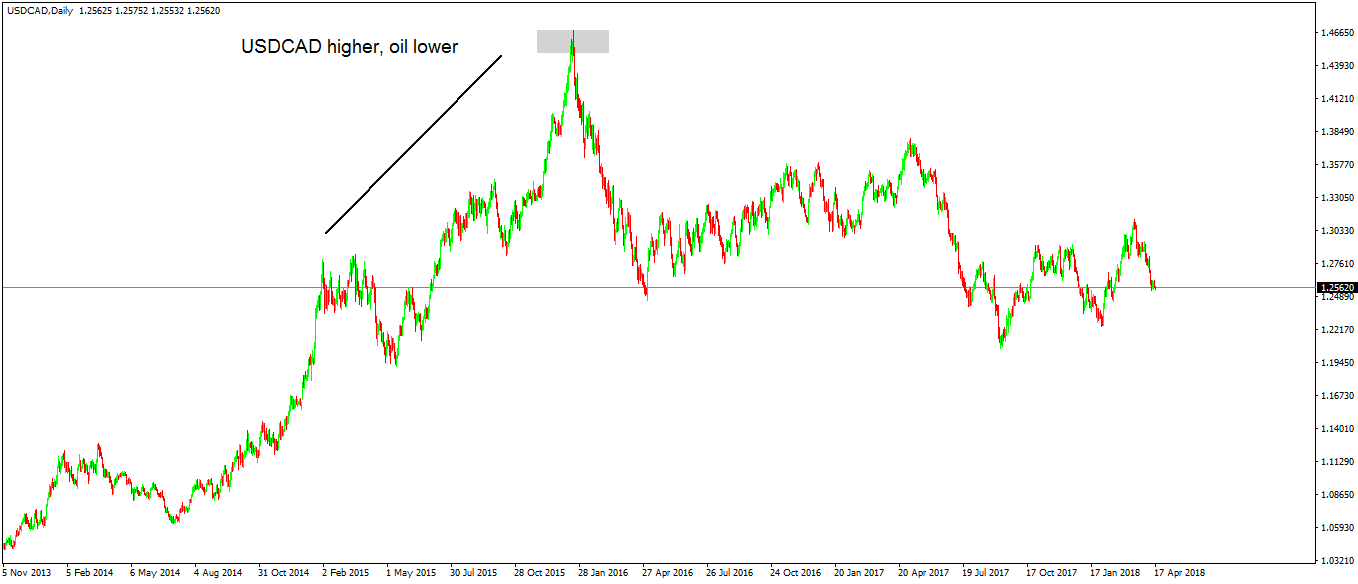Oil and CAD Correlation: A Guide to Trade the Two
Forex trading in the 21st century changed as brokers gained access to new technologies. The rising Internet penetration brought more and more traders to the market, attracted by the unlimited potential of the largest market in the world.
As a result, stiff competition among Forex brokers led to many financial products to be added to a regular trading account. Besides the regular currency pairs, the Forex dashboard has come to contains commodities like oil, gold, silver and other precious metals, bonds, indices, and even some other exotic financial products.
Because of that, Forex trading isn’t only about currencies anymore, but about everything that is part of the Forex dashboard. If you think of the fact that financial markets have a rising correlation degree, the step Forex brokers took was only a logical one.
If you ask a dedicated Forex trader if he/she trades the oil market from time to time, the chances are that you’ll get a negative answer. However, that’s far from the truth.
Various financial markets enjoy a direct or indirect correlation. Sometimes it is so powerful, that trading one is similar to trading another.
The perfect example comes from Switzerland. For years, the Swiss National Bank (SNB) pegged the EURCHF to the 1.20 level. The fear of a massive appreciation of the CHF against the EUR led the SNB to pour massive amounts into protecting the barrier.
For years, the EURCHF and the 1.20 level were subject to many debates. Being a cross pair, its trades were influenced by what the other two major pairs did: the EURUSD and the USDCHF.
With the 1.20 as the line in the sand, the more the EURCHF got closer to 1.20, the tighter the inverse correlation between the EURUSD and USDCHF became. In other words, on the 1.20 EURCHF rate, the correlation would be one hundred percent.
Therefore, it was impossible to have a bullish scenario for example, on both EURUSD and USDCHF. Inevitably, the other pair would do the opposite.
Hence, trading in those years had its weird implications given by the peg. Taking one trade on the EURUSD and one in the opposite direction on the USDCHF would equal taking the same trade twice on both pairs.
Oil and CAD
Correlations like the one described above don’t exist anymore. And even that one was artificially created.
However, there are financial instruments closely correlated, that pose the danger of overtrading an account if not aware of them. Such a correlation exists between the oil price and the Canadian Dollar (CAD).

Canada is an energy-driven economy. Its large oil sands reserves and oil industry made it one of the powerhouses in the Northern hemisphere.
It is no wonder the oil industry is home to the largest number of employees. Or, that the oil revenues directly influence the economic performance, with repercussion in the GDP (Gross Domestic Product) numbers.
Therefore, the price of oil influences the performance of the Canadian economy. Hence, it influences the value of its currency, the Canadian Dollar.
In Forex trading, everyone knows that when oil drops, the CAD drops too. Or, when the price of oil rises, the CAD rises also.
Though it may not be a direct correlation like the one described earlier, it is a correlation none the less.

Oil Market Particularities
Oil forever changed the world we live in. For a relatively new product (barely a hundred years old), it has had dramatic implications in everything we do.
Think of any product or service associated with a 2018 lifestyle, and it is impossible not to have a drop of oil in it. Be it plastic, transportation, and many others, oil and oil-derivative products changed our world. For good.
But oil is a commodity. As such, it comes in limited supplies, and it depends on supply and demand levels.

Unlike a currency, there is a finite quantity of oil. A central bank may decide to increase the money supply in the economy, thus printing more money. You can’t do that with oil or with any other commodity as a matter of fact.
For this reason, production and inventory levels, as well as discoveries strongly affect the price of oil.
In Forex trading, oil is even more critical. Its inflationary component is so strong that central banks always consider the price of oil before making changes in the monetary policy.
When oil dropped from above $100 to below $30, it sent shockwaves throughout the financial world. Everyone knew what would happen: inflation would decline. The only question was by how much?
And inflation, indeed, dropped. All over the world, it hit levels not seen in generations.
In many cases, it dropped into negative territory, forcing central banks to reinvent/adapt traditional monetary policies to face such a challenge. The Bank of Japan, European Nordic central banks and even the Swiss National Bank and the European Central Bank did just that.
And all this time as the oil price fell, guess what happened to the CAD? It fell too, for obvious reasons explained earlier.
The USDCAD rose so dramatically that it reached values over 1.46, making many Americans cross the border into Canada to buy cheaper products.

In time, the correlation weakens or becomes even stronger. For example, when the oil price started to slide from above $100, USDCAD made a move below $30.
However, the price of oil recovered, trading these days (first quarter of 2018) above the $70 mark. Yet, the USDCAD already recovered all the more.
But in principle, this is an excellent example of how correlations affect Forex trading. Timing may be tricky in some cases, but the idea remains the same.
Conclusion
Obviously, the risk here is to overemphasize the oil and CAD correlation for the times to come. For you see, as mentioned earlier, the oil as a commodity exists only for a relatively short period.
However, Canada and the Canadian Dollar existed earlier and will continue to exist. We don’t know yet for how long oil will play the dominant role it plays today, and how its price will evolve.
The CAD and oil correlation is just one of many seen in Forex trading. Because of it, traders of CAD must consider the oil-related news that affects its price. Hence, news that will change the value of the Canadian Dollar.
News like the inventory levels in the United States (Canada exports over two-thirds of its oil products to the United States, as they share a common border), OPEC (Organization of Petroleum Exporting Countries) meetings, disruptions in supply and demand levels, etc., result in fluctuations in the price of oil. For as long as this happens, the CAD will change in value too.
Technological breakthroughs provide new ways to find and exploit oil reserves. For this reason, it may be possible in the future to access proven reserves in places we can’t exploit today (e.g., Alaska). Any discoveries/quantities will make the price of oil fluctuate, and so will the CAD.
Later in this Trading Academy, we’ll present other correlations between currencies and other markets. One notable correlation is the one between the JPY and the U.S. equity markets. Or, another one is the one between gold and the Australian Dollar (AUD).
One thing is for sure: Forex trading today is not only about currencies. Instead, it is about understanding the complexities of the financial world and adapting a trading strategy in such a way to protect the trading account and to profit from the market swings.


